
Eucalyptus olida is a species of small to medium-sized tree that is endemic to a restricted area of New South Wales. It has rough, flaky and fibrous bark on the trunk and larger branches, lance-shaped to curved adult leaves, flower buds in groups of seven to fifteen or more, white flowers and barrel-shaped or bell-shaped fruit.
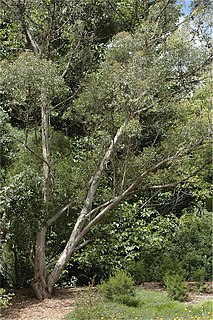
Eucalyptus olsenii, commonly known as the Woila gum, is a species of small tree that is endemic to a restricted area on the Southern Tablelands of New South Wales. It has smooth bark with rough bark on the lower trunk, lance-shaped to curved adult leaves, flower buds in groups of seven, white flowers and barrel-shaped or urn-shaped fruit.

Eucalyptus rubida, commonly known as candlebark, ribbon gum or white gum, is a species of small to medium-sized tree that is endemic to south-eastern Australia. It has smooth bark, sometimes with rough bark at the base, lance-shaped or curved adult leaves, flower buds in groups of three, white flowers and cup-shaped, hemispherical or bell-shaped fruit.
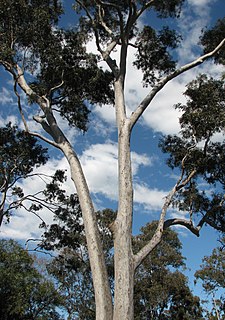
Corymbia maculata, commonly known as spotted gum, is a species of medium-sized to tall tree that is endemic to eastern Australia. It has smooth, mottled bark, lance-shaped to curved adult leaves, flower buds usually in groups of three, white flowers and urn-shaped or barrel-shaped fruit.

Eucalyptus camphora, commonly known as swamp gum is a flowering plant that is endemic to south-eastern Australia. It is a species of small to medium-sized tree with smooth bark, sometimes rough at the base, broadly lance-shaped to egg-shaped or elliptic adult leaves, flower buds in groups of seven, white flowers and conical fruit. There are two subspecies, subspecies camphora, commonly known as broad-leaved sally or swamp gum and subspecies humeana, commonly known as mountain swamp gum.

Eucalyptus dawsonii, known as slaty gum or slaty box, is a species of small to medium-sized tree that is endemic to a small area of New South Wales. It has smooth, white, grey or yellow bark, sometimes with a short stocking of rough, flaky bark, lance-shaped to curved adult leaves, flower buds in groups of seven on a branching inflorescence, white flowers and conical to barrel-shaped fruit.
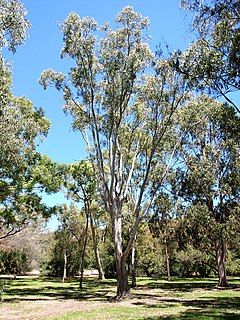
Eucalyptus amplifolia, commonly known as the cabbage gum, is a tree that is endemic to eastern Australia. It has smooth bark on its trunk and branches, lance-shaped leaves, and buds in groups of between seven and fifteen or more. The flowers are white and the fruit are woody hemispherical capsules. It is common on the coastal areas and tablelands of New South Wales and adjacent areas in south eastern Queensland, occurring as far south as Bega.

Corymbia henryi, commonly known as the large-leaved spotted gum, is a species of small to medium-sized tree that is endemic to north-eastern Australia. It has smooth, mottled bark, lance-shaped adult leaves, flower buds in groups of three, white or lemon yellow flowers and barrel-shaped to urn-shaped fruit.

Eucalyptus dorrigoensis, commonly known as the Dorrigo white gum, is a species of tree that is endemic to New South Wales. It has smooth white, grey or pink bark, lance-shaped to curved adult leaves, flower buds in groups of seven, white flowers and cup-shaped, conical or hemispherical fruit.
Eucalyptus volcanica is a species of tree that is endemic to northern New South Wales. It has rough, fibrous to flaky bark on the trunk, smooth bark above, lance-shaped or curved adult leaves, flower buds in groups of seven, white or creamy white flowers and cup-shaped or barrel-shaped fruit.
Eucalyptus vicina, commonly known as the Manara Hills red gum, is a species of mallee in the family Myrtaceae and is endemic to western New South Wales. It has smooth bark, lance-shaped to curved adult leaves, flower buds in groups of seven, white flowers and cup-shaped or hemispherical fruit.
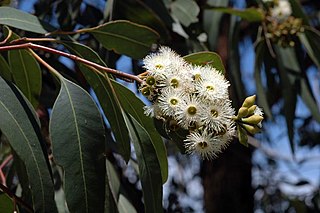
Eucalyptus ancophila is a tree endemic to a small area of New South Wales in eastern Australia. It has grey "ironbark", glossy green, lance-shaped leaves, flower buds arranged in a branching inflorescence with seven oval to diamond-shaped buds in each umbel, white flowers and conical or barrel-shaped fruit.
Eucalyptus hypostomatica, commonly known as Pokolbin box, is a species of erect, medium-sized to tall tree that is endemic to New South Wales. It has rough, flaky bark on the trunk and larger branches, lance-shaped adult leaves, flower buds in groups of seven, white flowers and barrel-shaped or conical fruit.

Eucalyptus nandewarica, commonly known as mallee red gum, is a species of tree or mallee that is endemic to a small area of western New South Wales. It has mostly smooth bark, lance-shaped adult leaves, flower buds in groups of three or seven, white flowers and cup-shaped or hemispherical fruit.
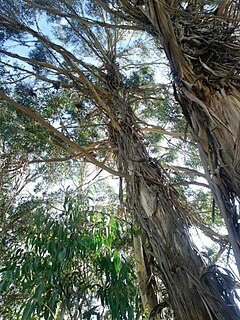
Eucalyptus nobilis, commonly known as ribbon gum or giant white gum, is a species of medium to tall tree that is native to northern New South Wales and south-east Queensland. It has a long, straight trunk with smooth, greyish bark that is shed in long ribbons, lance-shaped or curved adult leaves, flower buds in groups of seven, white flowers and cup-shaped or hemispherical fruit.

Eucalyptus prava, commonly known as orange gum, is a species of small to medium-sized tree that is endemic to eastern Australia. It has smooth, mottled bark, lance-shaped or curved adult leaves, flower buds in groups of seven, white flowers and cup-shaped or hemispherical fruit.

Eucalyptus kessellii, commonly known as Jerdacuttup mallee, is a species of mallee that is endemic to an area along the south coast of Western Australia. It has very hard, rough bark on the trunk of larger specimens, smooth greyish and brownish bark above, lance-shaped to egg-shaped adult leaves, flower buds in groups of three or seven, creamy white flowers and downturned, conical to cup-shaped fruit.
Eucalyptus delicata is a species of tree that is endemic to Western Australia. It has rough, fibrous to scaly bark on the trunk, smooth white to greyish bark above, linear to narrow lance-shaped adult leaves, flower buds in groups of between seven and eleven, creamy white flowers and more or less spherical to barrel-shaped fruit.
Eucalyptus glomericassis, commonly known as scarp white gum, is a species of small tree that is endemic to the Northern Territory. It has smooth bark, lance-shaped to curved adult leaves, flower buds in groups of seven, white flowers and conical fruit.
Eucalyptus scopulorum is a species of small tree that is endemic to a small area of northern New South Wales. It has rough ironbark on the trunk and branches, lance-shaped adult leaves, flower buds in groups of seven, white flowers and barrel-shaped or conical fruit.















